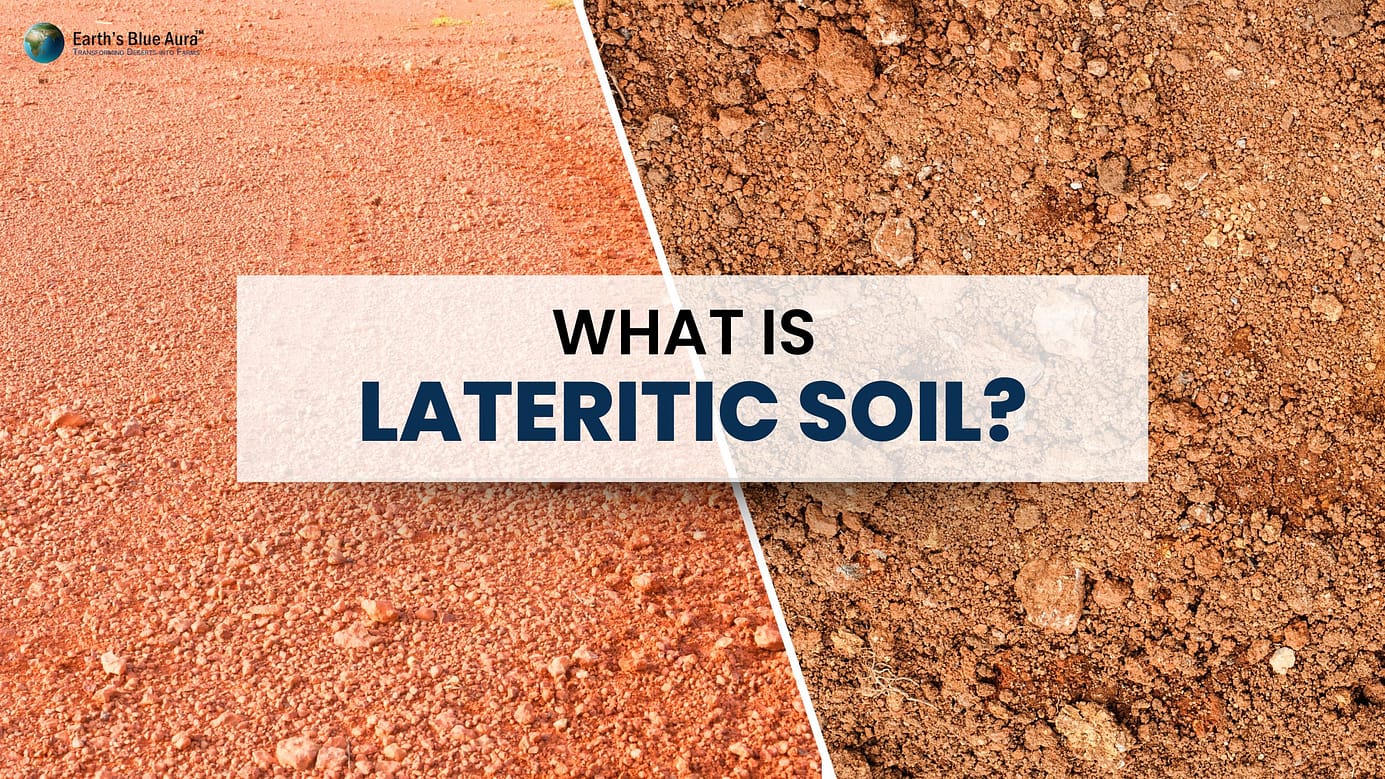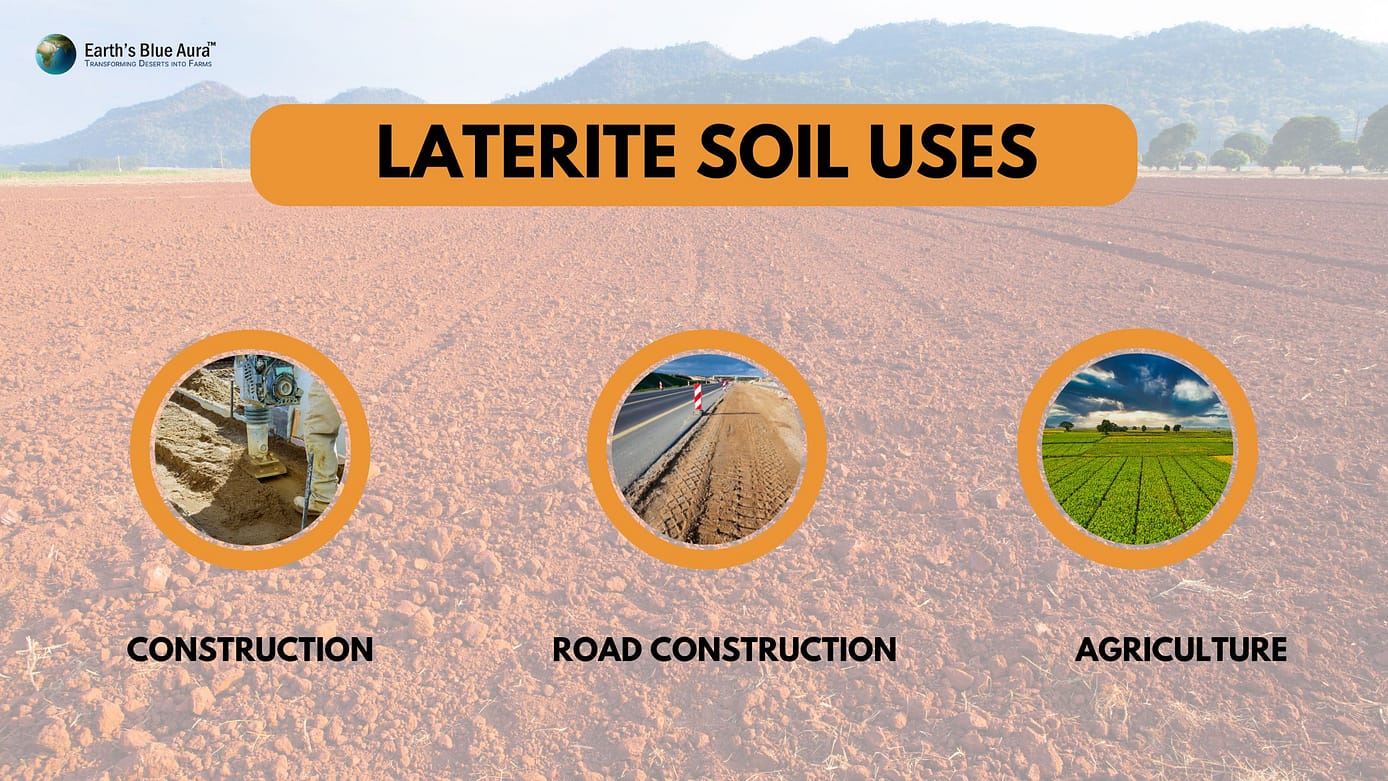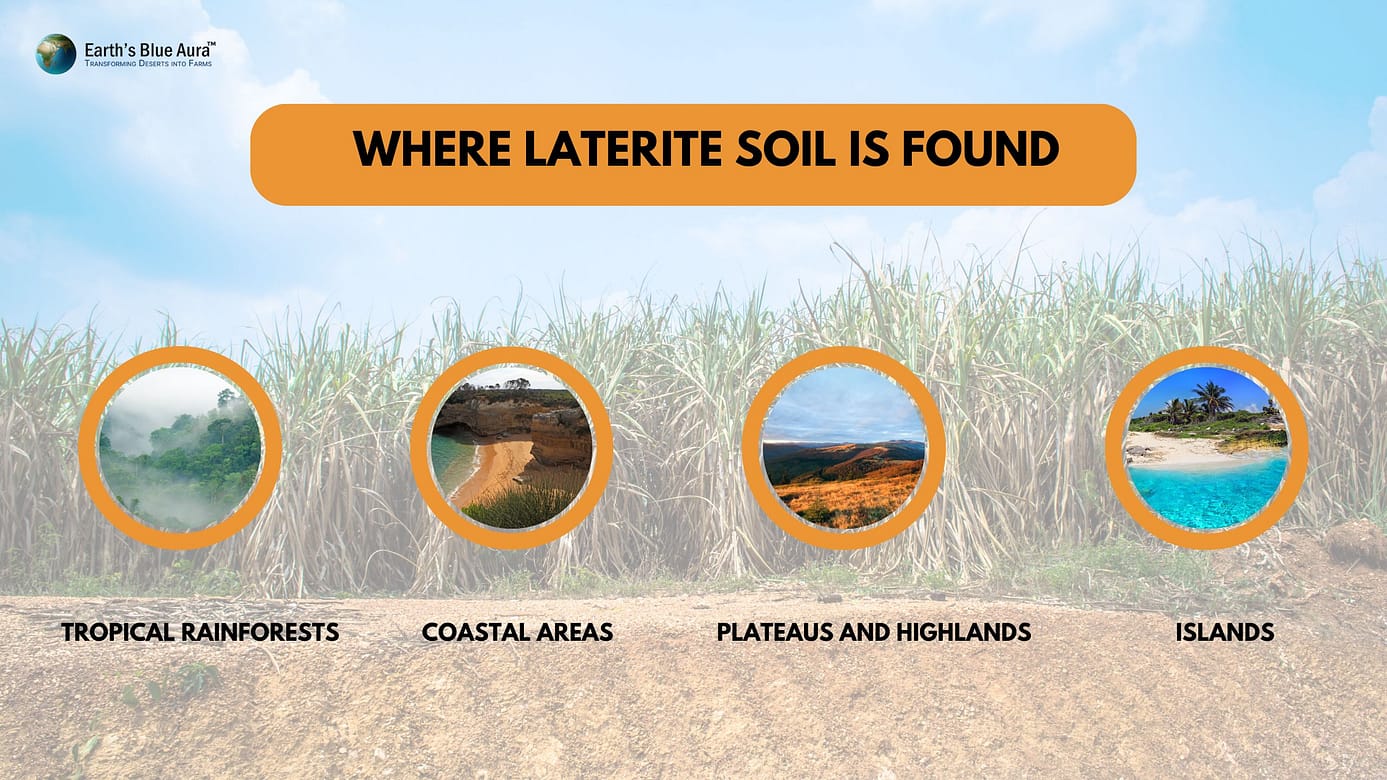Laterite soil, often referred to as “lateritic soil,” is a type of soil commonly found in tropical regions characterised by high temperatures and heavy rainfall. Its distinct properties and composition make it both valuable and challenging for agricultural and construction purposes. Understanding laterite soil requires delving into its formation, characteristics, uses, and management practices.
What is Lateritic Soil?
Laterite soil is formed through a process known as laterization, which occurs over long periods of time under specific environmental conditions. The process begins with the weathering of parent rock material, typically rich in iron and aluminium minerals, such as basalt, granite, or gneiss. As rainwater percolates through these rocks, it leaches out soluble minerals, leaving behind a residue of iron and aluminium oxides.
Over time, the accumulated iron and aluminium oxides undergo further chemical reactions, resulting in the formation of secondary minerals like kaolinite, hematite, and goethite. These minerals contribute to the distinctive red or orange coloration observed in laterite soil. The slow weathering process also leads to the development of a hard and compact layer known as a duricrust on the soil surface.
Laterite Soil Formation Information
Laterite soil, prevalent in tropical regions, forms gradually through the weathering of iron and aluminium-rich parent rocks over time. Key factors such as climate, topography, and microbial activity shape its development. In these regions, high temperatures and heavy rainfall accelerate chemical reactions and leaching processes, leading to the transformation of primary minerals into secondary ones like iron oxides. The topography plays a crucial role, with flat terrain favouring the accumulation of weathering products and thicker soil layers. Additionally, microbial activity influences soil chemistry and fertility, further impacting laterite soil formation.
Understanding the interplay of these factors is essential for assessing laterite soil’s characteristics and applications. Its unique properties make it suitable for certain agricultural and construction purposes, but its limitations, such as low fertility, must be managed effectively. By considering the environmental context and employing appropriate management practices, laterite soil can be utilised sustainably, contributing to food security and infrastructure development in tropical regions.
Laterite’s Chemical Composition
Laterite soil is made up mostly of iron and aluminium oxides, which come from rocks breaking down over a long time. When rocks are exposed to the weather, like rain and heat, they slowly wear away, leaving behind these iron and aluminium compounds. These compounds give laterite soil its distinctive red or orange colour. Along with iron and aluminium, laterite soil can also have other things in it, like silica, clay minerals (which help give the soil its texture), and small amounts of metals like manganese, titanium, and nickel. These elements and minerals all come together to make laterite soil what it is.
Understanding the chemical makeup of laterite soil helps us know how it can be used. For example, because it’s rich in iron and aluminium, laterite soil is often used in construction, especially in places where other building materials are hard to find. Its colour and texture also make it useful for agriculture, although it might need extra nutrients added to help plants grow well. By knowing what’s in laterite soil, we can make the most of its properties for different purposes, from building houses to growing crops.
Laterite Soil Colour and Physical Description
Laterite soil has a distinct colour and physical appearance. It’s often reddish or orange in colour, which comes from the iron oxides in the soil. These iron oxides give the soil a rusty look. When you see laterite soil, it might remind you of clay or mud because it can be quite soft and sticky when wet. But when it dries out, it becomes hard and solid, almost like rock. You might even find it forming layers that look like steps in the ground. Despite its hardness when dry, laterite soil can also be crumbly and easy to break apart.
Because of its colour and texture, laterite soil is sometimes called “brick soil” because it’s used to make bricks for building. Its ability to harden when it dries makes it useful for constructing houses and roads in places where other materials are scarce. Farmers also use laterite soil for agriculture, although they might need to add extra nutrients to help plants grow well. Overall, laterite soil’s unique colour and physical properties make it valuable for various purposes, from construction to farming.
Laterite Soil Uses
Laterite soil is handy for different things:
Construction: People use laterite soil to build things like houses and walls because it can harden when it dries out. They can shape it into bricks or blocks, which makes it useful for construction projects. It’s often used in places where other building materials are hard to find.
Road Construction: Laterite soil is also good for making roads and paths. Its toughness when dry means it can handle the weight of vehicles. Plus, it’s good at staying firm even during heavy rains, which makes it great for building roads in places with lots of rain.
Agriculture: Farmers sometimes use laterite soil for growing crops. Even though it might not have all the nutrients plants need, they can add fertilisers to help plants grow better. Its ability to hold water can also be useful for keeping plants hydrated, especially in hot climates.
Environmental Characteristics
Laterite soil has distinct environmental traits:
High Iron Content: One key aspect of laterite soil is its abundance of iron. This comes from the breakdown of rocks that contain iron minerals. This iron gives laterite soil its reddish or orangish colour. While this iron can be useful for certain things like building, it can also impact the soil’s properties, such as how it holds water and nutrients.
Low Nutrient Content: Another important feature of laterite soil is its low levels of nutrients. This means it doesn’t have much of the necessary nutrients that plants need to grow well, like nitrogen, phosphorus, and potassium. Because of this, plants might not grow as effectively in laterite soil unless extra nutrients are added, usually through fertilisers or organic materials. Managing these nutrient levels is crucial for successful farming in areas where laterite soil is present.
Types of Laterites
Laterite soils can be classified into two main types based on their development and characteristics:
Saprolitic Laterites: These laterites have a well-developed soil profile, with distinct layers formed through weathering processes. They typically have a thick layer of weathered material overlying unweathered bedrock. Saprolitic laterites often have a higher clay content and better nutrient retention compared to other types. They are commonly found in regions with moderate to high rainfall and relatively stable geological conditions.
Plinthitic Laterites: Plinthitic laterites are characterised by the presence of iron and aluminium oxides near the soil surface, forming hardened nodules or crusts known as iron pans or plinthite. These nodules can hinder root penetration and water infiltration, impacting agricultural productivity. Plinthitic laterites are typically found in regions with seasonal climates, where alternating wet and dry periods promote the formation of iron and aluminium oxides near the soil surface.
Laterite and Lateritic soils – What are they?
Laterite and lateritic soils are types of soils that form in tropical and subtropical regions through a process called laterization. Laterite soil is the mature form, while lateritic soil is an intermediate stage in the laterization process.
Laterite soil is characterised by its rich content of iron and aluminium oxides, giving it a distinctive red or orange colour. It forms through the weathering of parent rocks over long periods under specific environmental conditions, such as high temperatures and heavy rainfall. Laterite soil typically has a well-developed soil profile with distinct layers, including a hard and compact layer on the surface known as duricrust.
Lateritic soil, on the other hand, is an earlier stage of laterite soil development. It exhibits characteristics of both weathered and unweathered materials and may contain varying amounts of iron and aluminium oxides. Lateritic soils are often found in regions undergoing active weathering processes, with features such as iron-rich nodules or crusts known as iron pans or plinthite. Over time, lateritic soils may further develop into mature laterite soils through continued weathering and soil formation processes.
Both laterite and lateritic soils play important roles in tropical ecosystems and have various applications in agriculture, construction, and environmental conservation. Understanding their formation and properties is essential for effective land management and sustainable development in tropical regions.
Laterite vs Lateritic Soil – what is the difference?
Laterite soil and lateritic soil are closely related, but there are some key differences between them:
Maturity: Laterite soil is the more mature form, while lateritic soil is an earlier stage in the process of soil development known as laterization. Laterite soil has undergone more extensive weathering and has a well-developed soil profile with distinct layers, including a hard surface layer called duricrust. Lateritic soil, on the other hand, is still in the process of developing its characteristics and may exhibit features of both weathered and unweathered materials.
Composition: Laterite soil typically has a higher concentration of iron and aluminium oxides compared to lateritic soil. This gives laterite soil its characteristic red or orange colour and contributes to its hardness and durability. Lateritic soil may contain varying amounts of iron and aluminium oxides, but it may not be as rich in these minerals as laterite soil.
Features: Lateritic soil often exhibits features such as iron-rich nodules or crusts known as iron pans or plinthite. These features may not be as pronounced in laterite soil, which tends to have a more uniform and well-developed structure. Additionally, laterite soil is more commonly associated with fully developed tropical ecosystems, while lateritic soil may be found in areas undergoing active weathering processes.
Where Laterite Soil is Found
Laterite soil is typically found in tropical and subtropical regions around the world. These areas are characterised by high temperatures, heavy rainfall, and prolonged periods of weathering, which are conducive to the formation of laterite soil. Some specific regions where laterite soil is commonly found include:
Tropical Rainforests: Laterite soil is prevalent in tropical rainforest regions, such as the Amazon Basin in South America, the Congo Basin in Africa, and parts of Southeast Asia. The warm, humid climate and abundant rainfall in these areas promote the weathering of rocks and the development of laterite soil.
Coastal Areas: Coastal regions in tropical climates often have laterite soil due to the combination of high temperatures, rainfall, and proximity to the ocean. Examples include coastal areas of India, Sri Lanka, and parts of Australia.
Plateaus and Highlands: Laterite soil can also be found in elevated areas such as plateaus and highlands in tropical regions. These areas may experience intense weathering processes due to factors like elevation, slope, and exposure to rainfall. Examples include the Deccan Plateau in India and the Guiana Highlands in South America.
Islands: Many tropical islands have laterite soil, particularly those located in the Pacific and Indian Oceans. The combination of volcanic activity, high rainfall, and warm temperatures contributes to the formation of laterite soil on these islands.
Laterite Soil Minerals and Ores
Laterite soil contains minerals and ores that are formed through the weathering of rocks over time. One of the main minerals found in laterite soil is iron oxide, which gives the soil its reddish or orange colour. Other common minerals include aluminium oxide, silica, and clay minerals. These minerals are often the result of chemical reactions between the rock material and environmental factors like rain and heat.
Additionally, laterite soil may contain small amounts of ores, which are minerals that contain valuable elements or metals. Some examples of ores found in laterite soil include nickel, cobalt, and manganese. These ores can be extracted and processed for various industrial purposes, such as making stainless steel or batteries. Overall, the minerals and ores present in laterite soil contribute to its unique characteristics and potential economic value.
Appropriate Crops Grown in Laterite Soils
In laterite soils, some crops grow better than others because of the soil’s characteristics. Some crops that do well in laterite soils include:
Cassava: Cassava is a root vegetable that can thrive in laterite soils because it’s tolerant to poor soil conditions and drought. It’s a staple food in many tropical regions and can be grown successfully in areas with low soil fertility.
Pineapple: Pineapple is a tropical fruit that can grow in laterite soils due to its ability to tolerate acidic conditions. It requires well-drained soil, which laterite soils can provide, making it a suitable crop for cultivation.
Oil Palm: Oil palm is a type of tree that produces palm oil, which is widely used in cooking and various industries. It can grow well in laterite soils, especially in regions with high rainfall and warm temperatures.
Rubber: Rubber trees are another crop that can thrive in laterite soils. They require well-drained soil and regular rainfall, both of which are characteristic of many areas with laterite soils.
The Distinction between Laterite and Red Soil
Laterite soil and red soil are different types of soil, but they can sometimes look similar because of their reddish colour. Here are some simple differences between them:
Formation: Laterite soil forms from the weathering of rocks rich in iron and aluminium minerals over a long time. Red soil, on the other hand, gets its colour from iron oxide but forms through a different process, often involving the weathering of different types of rocks like granite or limestone.
Composition: Laterite soil usually has a higher concentration of iron and aluminium oxides compared to red soil. This gives laterite soil its distinctive reddish or orangish colour and contributes to its hardness and durability.
Location: Laterite soil is commonly found in tropical and subtropical regions with high temperatures and heavy rainfall. Red soil, on the other hand, can be found in a wider range of climates and environments, including temperate regions.
Conclusion
In summary, laterite soil stands as a testament to the intricate processes of weathering and soil formation, particularly in tropical and subtropical climates. Its distinctive properties, stemming from high concentrations of iron and aluminium oxides, shape its utility and challenges in agricultural and construction contexts. Through an understanding of its formation mechanisms, chemical composition, and physical characteristics, we can navigate its complexities to harness its potential effectively.
Despite its limitations, laterite soil offers valuable resources for sustainable development in tropical regions. By recognizing its suitability for specific crops and its resilience in construction projects and road building, we can leverage its benefits while mitigating its constraints. Through thoughtful management practices and continued research, we can ensure the responsible utilisation of laterite soil resources, contributing to food security, infrastructure development, and environmental conservation efforts in tropical environments.
FAQs About Laterite Soil
Can laterite soil support agriculture?
Yes, with proper management practices and supplementation, certain crops can be cultivated in lateritic soils.
What are the main components of laterite soil?
Laterite soil primarily consists of iron and aluminum oxides, along with silica, clay minerals, and organic matter.
Where is lateritic soil commonly found?
Lateritic soil is predominantly found in tropical regions with hot temperatures and heavy rainfall.
What are the uses of laterite soil in construction?
Laterite soil is commonly used as a building material and in road construction due to its durability and load-bearing capacity.
How does lateritic soil differ from red soil?
While both lateritic and red soils share a reddish color due to iron oxide content, they differ in their formation processes and physical characteristics.
Can laterite soil support agriculture?
Yes, laterite soil can support agriculture with proper management practices and supplementation. While laterite soil may have low nutrient content initially, farmers can enhance fertility by adding organic matter or fertilisers. Additionally, selecting crops that are well-suited to the soil’s characteristics, such as cassava or pineapple, can lead to successful cultivation in lateritic soils.
What are the main components of laterite soil?
Laterite soil mainly consists of iron and aluminium oxides, which give it its distinctive reddish or orangish colour. Alongside these oxides, lateritic soil may also contain silica, clay minerals, and organic matter. Understanding these components helps in assessing the soil’s properties and suitability for various applications.
Where is lateritic soil commonly found?
Lateritic soil is commonly found in tropical regions characterised by high temperatures and heavy rainfall. These environmental conditions facilitate the weathering of parent rocks rich in iron and aluminium minerals, leading to the formation of laterite soil over time.
What are the uses of laterite soil in construction?
Laterite soil is widely used in construction due to its durability and load-bearing capacity. It can be shaped into bricks or blocks for building houses, walls, and other structures. Additionally, its hardness when dry makes it suitable for road construction, providing a stable surface even during heavy rains.
How does lateritic soil differ from red soil?
While both lateritic and red soils share a reddish colour due to iron oxide content, they differ in their formation processes and physical characteristics. Lateritic soil forms through the weathering of iron and aluminium-rich parent rocks over time, resulting in a well-developed soil profile. In contrast, red soil may form through the weathering of different rock types and may lack the distinct layers and durability of lateritic soil.



